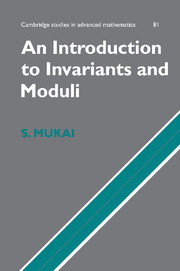Book contents
- Frontmatter
- Contents
- Preface
- Acknowledgements
- Introduction
- 1 Invariants and moduli
- 2 Rings and polynomials
- 3 Algebraic varieties
- 4 Algebraic groups and rings of invariants
- 5 The construction of quotient varieties
- 6 The projective quotient
- 7 The numerical criterion and some applications
- 8 Grassmannians and vector bundles
- 9 Curves and their Jacobians
- 10 Stable vector bundles on curves
- 11 Moduli functors
- 12 Intersection numbers and the Verlinde formula
- Bibliography
- Index
- References
1 - Invariants and moduli
Published online by Cambridge University Press: 05 February 2015
- Frontmatter
- Contents
- Preface
- Acknowledgements
- Introduction
- 1 Invariants and moduli
- 2 Rings and polynomials
- 3 Algebraic varieties
- 4 Algebraic groups and rings of invariants
- 5 The construction of quotient varieties
- 6 The projective quotient
- 7 The numerical criterion and some applications
- 8 Grassmannians and vector bundles
- 9 Curves and their Jacobians
- 10 Stable vector bundles on curves
- 11 Moduli functors
- 12 Intersection numbers and the Verlinde formula
- Bibliography
- Index
- References
Summary
This chapter explores some examples of parameter spaces which can be constructed by elementary means and with little previous knowledge as an introduction to the general theory developed from Chapter 3 onwards. To begin, we consider equivalence classes of plane conics under Euclidean transformations and use invariants to construct a parameter space which essentially corresponds to the eccentricity of a conic.
This example already illustrates several essential features of the construction of moduli spaces. In addition we shall look carefully at some cases of finite group actions, and in particular at the question of how to determine the ring of invariants, the fundamental tool of the theory. We prove Molien's Formula, which gives the Hilbert series for the ring of invariants when a finite group acts linearly on a polynomial ring.
In Section 1.3, as an example of an action of an algebraic group, we use classical invariants to construct a parameter space for GL(2)-orbits of binary quartics.
In Section 1.4 we review plane curves as examples of algebraic varieties. A plane curve without singularities is a Riemann surface, and in the particular case of a plane cubic this can be seen explicitly by means of doubly periodic complex functions. This leads to another example of a quotient by a discrete group action, in this case parametrising lattices in the complex plane. The group here is the modular group SL(2, ℤ) (neither finite nor connected), and the Eisenstein series are invariants. Among them one can use two, g2 and g3, to decide when two lattices are isomorphic.
A parameter space for plane conics
Consider the curve of degree 2 in the (real or complex) (x, y) plane
ax2 + 2bxy + cy2 + 2dx + 2ey + f = 0
If the left-hand side factorises as a product of linear forms, then the curve is a union of two lines; otherwise we say that it is nondegenerate (Figure 1.1).
- Type
- Chapter
- Information
- An Introduction to Invariants and Moduli , pp. 1 - 50Publisher: Cambridge University PressPrint publication year: 2003



